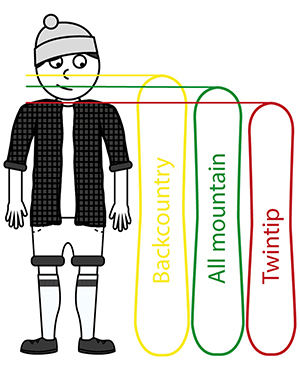Purchasing Snowboards
Your snowboard selection primarily hinges on your skill level and preference for riding style, whether it's on-piste, in the park, or off-piste. Additional critical elements to consider include your foot size, weight, and height.
How to Determine the Right Length and Width for Your Snowboard
- Snowboard Length is influenced by your terrain preference and height. Generally, your snowboard should reach somewhere between your shoulders and the centre of your head. Typically, longer boards are suggested for backcountry/off-piste, whilst shorter ones are ideal for freestyle tricks. A board with an intermediate length is adaptable for all-mountain activities.
Beginners and children are usually advised to opt for slightly shorter boards to ensure a simpler and more enjoyable snowboarding experience. You can find guidance on sizes on the specific snowboard product pages when available.
Brands have recently introduced model-specific size charts that also take weight into account. This is possibly the best method for selecting the correct snowboard length. - Snowboard Width generally falls into two categories: Standard and Wide. Wide boards are recommended for those with shoe size 44 and above. This rule does not apply to junior wide boards, as an exception.

Exploring the Three Varieties of Snowboards
- Twintip snowboards are designed for park activities and stunts, and also provide enjoyment on the piste. The front and rear of the snowboard are perfectly symmetrical and the bindings are centred, facilitating ease in alternating directions and landing tricks.
- All-Mountain snowboards are extremely adaptable. Their shape resembles that of a twintip snowboard, but the bindings, flex, and balance point are repositioned towards the back of the snowboard. This type of snowboard is an excellent purchase for most individuals, as it is appropriate for all mountain terrains, including on-piste, in the park, and off-piste.
- Backcountry: This snowboard is crafted for deep powder conditions off-piste. Its shape closely mirrors that of a surfboard, and its expansive surface delivers excellent buoyancy in deep snow.
Snowboard Design Varieties
Shape
- Directional: Designed for single-direction use, often employed on-piste or off-piste. Comes with a stiffer design at the aft, providing stability at higher speeds.
- Twin: Constructed with identical front and rear, making it suitable for parks and tricks. Twin-shaped snowboards can glide in both directions.
- Directional Twin: A hybrid of both shapes, frequently conceived for all-mountain and freestyle snowboards.
Baseline Design
A snowboard's base can differ and may be designed as camber, rocker, or flat. These designs are frequently combined, depending on the snowboard's intended use.

- Rocker: When a snowboard curves upwards at the tips, making it perfect for powder snow and smooth turns. It minimises drag and is effective in the park.
- Camber: The nose and tail of the snowboard press downwards into the snow, expanding contact with the snow and enhancing edge grip.
- Flat: Offers full contact with the snow's surface, resulting in more stability compared to a traditional rocker and facilitates easy turns.
